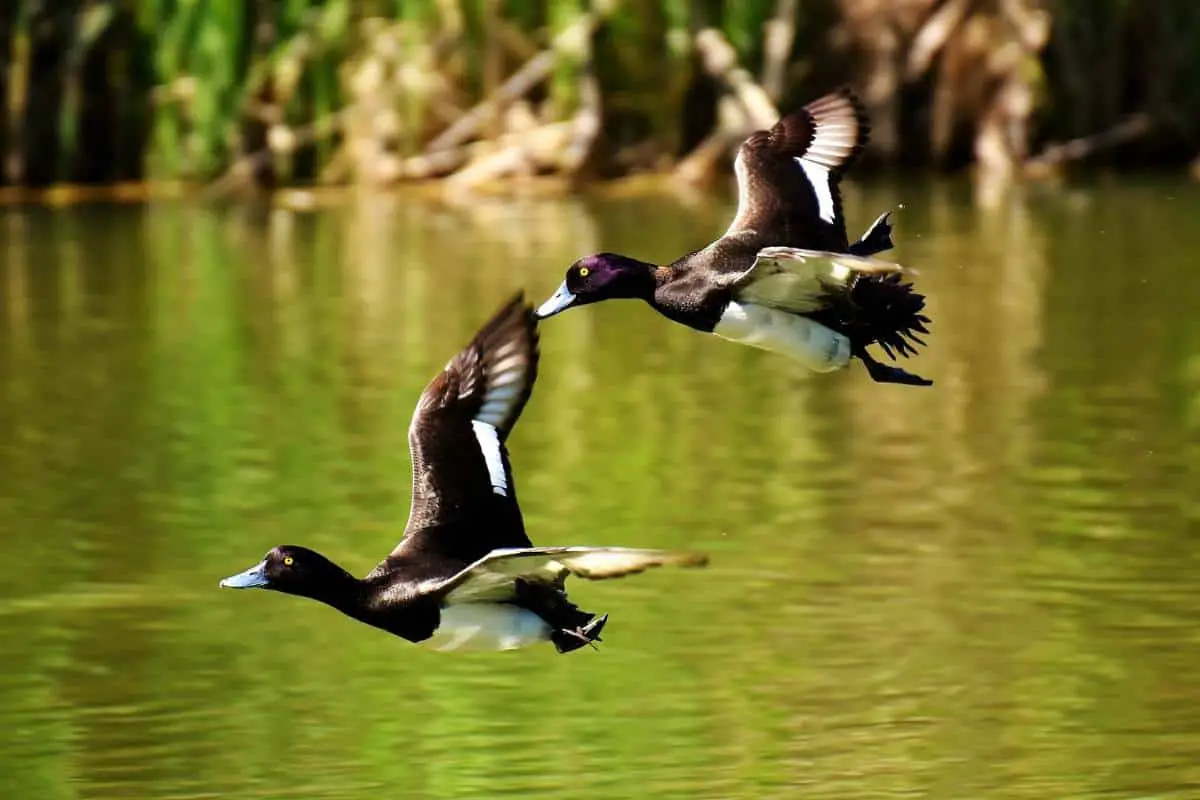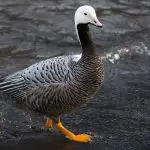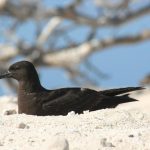Common Name: Tufted Duck
Scientific Name: Aythya fuligula| Size | Diet | Range in Hawaii | Status in Hawaii |
|---|---|---|---|
| 16 in. - 20 in. | small crustaceans, mollusks, and insect larvae | Oahu and Big Island | Least Concern |
The Tufted Duck (Aythya fuligula) is a striking and distinctive species of diving duck that is found in many parts of the world. With its tuft of feathers on top of its head and its sleek black and white plumage, the Tufted Duck is a fascinating bird to observe. While this species is not native to Hawaii, it has been spotted in the state on rare occasions.
In this article, we will explore the unique characteristics and behaviors of the Tufted Duck, as well as its presence in the Hawaiian Islands. So, get ready to learn about one of the most captivating diving ducks in the world!
Tufted Duck
Appearance

The Tufted Duck is a striking waterfowl species that commands attention with its unique and captivating appearance. This medium-sized diving duck boasts a sleek and streamlined body, designed for effortless navigation through the water. Measuring around 16 to 20 inches (40 to 51 centimeters) in length, the Tufted Duck is of moderate size, making it slightly smaller than some of its duck relatives.
What truly sets this species apart is its distinctive tufted crest, which adorns the male’s head. This striking feature gives the Tufted Duck its name and adds a touch of elegance to its overall appearance. Both males and females exhibit a rich, dark plumage, with males donning a black body contrasted by white flanks and a bright yellow eye.
In addition to their tufted crest, male Tufted Ducks also boast a striking iridescent purple sheen on their head and neck, adding a splash of color to their sophisticated attire. Females, on the other hand, exhibit a more subtle beauty, with a dark brown plumage that provides excellent camouflage in their natural habitats. Their understated elegance complements the vibrant males, creating a visual harmony within the Tufted Duck population.
Diet
This diving duck has an eclectic palate and relies on a diverse range of food sources to satisfy its nutritional needs. Primarily, the Tufted Duck is a carnivorous species, with a strong affinity for aquatic invertebrates. It eagerly feasts upon a smorgasbord of small crustaceans, mollusks, and insect larvae found in freshwater habitats.
Nesting
The nesting habits of the Tufted Duck offer a glimpse into the intricate world of avian parenthood and the strategies employed by this fascinating waterfowl species. Tufted Ducks are known for their affinity for nesting near water bodies. They prefer secluded locations that provide ample cover and protection for their nests, safeguarding their precious offspring from potential predators.
The female Tufted Duck takes the lead in nest building, crafting a well-hidden and carefully constructed structure using a combination of plant material, such as grass, reeds, and leaves. She skillfully weaves these natural materials into a sturdy cup-shaped nest, ensuring a safe and cozy haven for her eggs.
Once the nest is complete, the female begins the egg-laying process, typically laying around 8 to 12 eggs in a single clutch. These eggs possess a smooth, creamy white shell, serving as a beautiful contrast to the dark hues of the female’s plumage.
During the incubation period, which lasts approximately 26 to 28 days, the female assumes the primary responsibility of keeping the eggs warm and protected. She diligently tends to her nest, rarely leaving it unattended, while relying on her well-developed camouflage to blend seamlessly with the surrounding vegetation.
After the eggs hatch, the female Tufted Duck leads her adorable ducklings to the water, where they take their first tentative strokes, guided by their mother’s watchful guidance. As the ducklings grow, they become increasingly independent, honing their diving and foraging skills under the careful supervision of their vigilant parent.
Behavior
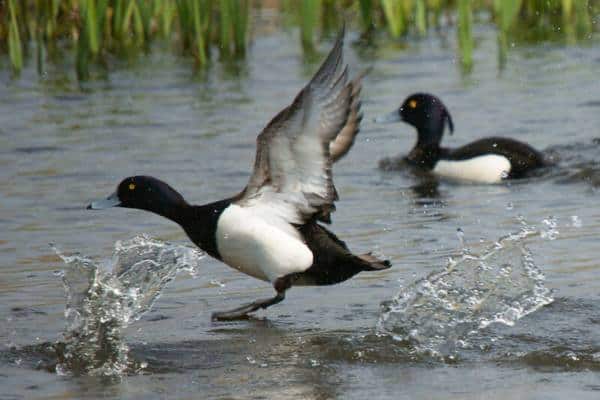
One noteworthy behavior of the Tufted Duck is its communal nature. Outside of the breeding season, they often gather in large flocks, creating a bustling and energetic spectacle on lakes, reservoirs, and coastal waters. These gatherings serve various purposes, including safety in numbers, finding optimal foraging spots, and engaging in social interactions.
During the breeding season, Tufted Ducks engage in elaborate courtship displays. Males display their splendid plumage, vigorously bob their heads, and emit distinct vocalizations to attract the attention of females. These courtship rituals not only showcase the male’s fitness but also establish hierarchy among competing males, ensuring successful pair bonding.
Once paired, Tufted Ducks exhibit a strong bond, engaging in synchronized swimming and displaying coordinated movements. This synchronized behavior not only strengthens their pair bond but also serves as a form of defense against potential threats.
When it comes to foraging, the Tufted Duck employs impressive diving skills. With their streamlined bodies and webbed feet, they dive underwater to seek out prey, sometimes reaching impressive depths. Their diet consists of both aquatic invertebrates and plant matter, and their feeding behavior showcases their ability to adapt to available food sources.
Another interesting behavior of the Tufted Duck is its ability to engage in aggressive interactions, particularly when defending territory or resources. Males can display aggressive behaviors toward intruders, employing threat displays, wing-flapping, and bill-snapping as deterrents.
Habitat
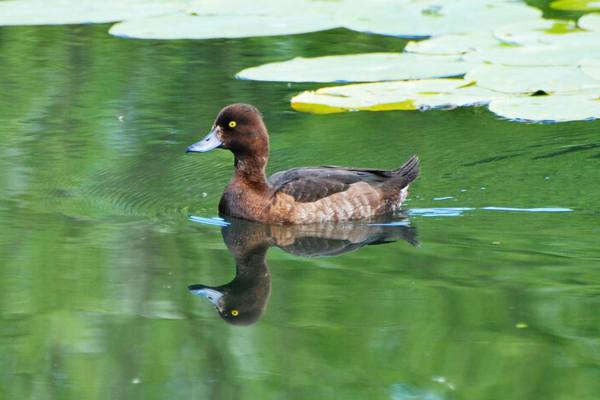
This waterfowl species can be found in both freshwater and brackish water habitats, where it creates its own unique niche. One of the preferred habitats of the Tufted Duck is freshwater lakes and ponds, especially those with rich vegetation and ample submerged aquatic plants. In addition to freshwater habitats, the Tufted Duck also frequents brackish water environments, such as coastal lagoons, estuaries, and sheltered bays.
Range
The Tufted Duck is not a native species to Hawaii, but there have been several sightings of the bird on both Oahu and the Big Island of Hawaii.
Conservation Status
The Tufted Duck (Aythya fuligula) is assessed as a species of “least concern” by the International Union for Conservation of Nature (IUCN). This classification indicates that the overall population of Tufted Ducks is stable, and they are not currently facing significant threats or experiencing significant population declines.
Interesting Facts
1. Diving expert
The Tufted Duck is an excellent diver, capable of descending to impressive depths of up to 20 meters (65 feet) in search of food. It can stay submerged for around 20-30 seconds, utilizing its streamlined body and webbed feet to navigate underwater.
2. A monogamous mates
Tufted Ducks are monogamous birds, forming long-term pair bonds during the breeding season. Mated pairs engage in synchronized swimming and cooperative behaviors.
3. They are vocal communicators
Tufted Ducks are known for their distinctive vocalizations. Males produce a low, hoarse call, while females emit a higher-pitched and softer quack.
4. Hybridization with other duck species
Tufted Ducks can occasionally hybridize with other closely related duck species, resulting in interesting mixed characteristics and plumage patterns.
5. Their wing whistles
During flight, male Tufted Ducks produce a distinctive whistling sound caused by air passing through their wing feathers. This sound can be heard as they take off or fly in groups.
Frequently Asked Questions
1. Are Tufted Ducks kept as pets?
Tufted Ducks are not commonly kept as pets. They are wild waterfowl and require specific habitat and dietary needs that are difficult to replicate in captivity. It is best to observe and appreciate them in their natural habitats.
2. How fast can Tufted Ducks fly?
Tufted Ducks can reach flying speeds of up to 50 miles per hour (80 kilometers per hour). Their powerful flight enables them to migrate long distances and evade predators.
3. How long do Tufted Ducks live?
Tufted Ducks have an average lifespan of around 5 to 10 years. However, some individuals have been known to live up to 20 years in the wild.
4. Are Tufted Ducks considered a game bird?
Yes, Tufted Ducks are commonly hunted as game birds in some regions. They are sought after for their meat and are legally hunted during regulated hunting seasons in accordance with local wildlife management practices.
5. Are Tufted Ducks aggressive towards humans?
Generally, Tufted Ducks are not known to be aggressive towards humans. They are typically wary of human presence and tend to keep their distance. However, like any wild animal, they may display defensive behaviors if they feel threatened or cornered.
